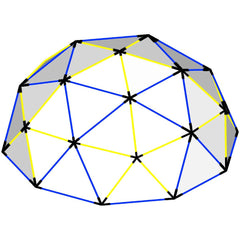Your Cart is Empty
<< Worldwide shipping >>
<< Worldwide shipping >>
<< Worldwide shipping >>
USE FOR ½" PVC
USE FOR 1" OR 1½" PVC
USE FOR ½" PVC
USE FOR 1" OR 1½" PVC
USE FOR ½" PVC
STANDARD DOME CALCULATOR
USE FOR 1" OR 1½" PVC
MEGADOME CALCULATOR
USE FOR ½" PVC
STANDARD SPHERE CALCULATOR
USE FOR 1" OR 1½" PVC
MEGASPHERE CALCULATOR
Welcome to the geodesic world, where math, science, engineering, architecture, and urban design all come into play. There are some basic concepts that will help you decide which dome kit is right for you, and some terms we use at Sonostar that may seem a little unfamiliar. Let’s get started.There are three variables you need to know to make the calculations that will determine which kit is the right one to buy.
1. Figure out what the diameter of your base is going to be. That’s going to determine the overall size of your dome. The radius is always half the diameter.
2. Determine what frequency your dome needs to be. That will determine how dense the triangle patterns are, as well as the roundness and strength of your dome.

Geodesic - This term comes from 2 Greek words. ‘Geo’ refers to the earth, especially its spherical shape. ‘Desic’ has to do with measurement. A literal meaning of ‘geodesic’ is ‘to measure the earth’. The ancient Greeks used triangles to measure many things, and they figured out how to actually measure a sphere using triangles. One particular guy, Eratosthenes, was able to measure the Earth to within 200 miles of its actual circumference.
Dome - a part of a sphere, usually measured in 1/8’s. A 4/8 dome would be a perfect hemisphere. A 3/8 dome would be just less than a hemisphere, and a 5/8 dome would be just a little bigger than a hemisphere.
Diameter/Radius - The diameter of a circle is the line straight across, through the center. This is how we usually measure the size of a dome or a sphere. A 10-meter dome is 10 meters across at the base. For a 4/8 hemisphere, the radius is the same as the height. Going from the center point of the dome’s base straight up to the top would be half the diameter (radius of a sphere = height). All domes are not 4/8 hemispheres, though, because of where the rows of triangles are placed. Odd frequency domes (3V & 5V) usually come in 3/8 or 5/8 (of a sphere) configurations.
Frequency - refers to the repetition of a pattern of triangles that can be used to approximate the surface of a dome or sphere. All Sonostar geodesic domes are made of these repeating patterns of triangles. The denser the triangle pattern, the higher the frequency. You’ll see 2V, 3V, 4V, 5V, 6V used to describe the frequency of different domes. The 2V is the least complex, using the fewest number of hubs (26) and struts (65), making it the least expensive, and also the least round, and the least strong. By contrast, a 6V (Frequency 6) dome uses the most hubs (196) and struts (594), is the most rounded and strongest structure of them all.
Standard vs. Mega - Sonostar has developed hub connectors that fit 3 sizes of standard Schedule 40 PVC pipe. This is the kind of pipe you can buy at Home Depot in their plumbing department. Standard size hubs correspond to ½” PVC pipe. Megahubs fit two sizes: 1” and 1 ½” PVC. For the 1” pipe, the inside of the hub arms is used. For 1 ½” pipe, it fits around the outside of the hub arm. Megahubs are much bigger than standard hubs.

Standard Hub (For use with 1/2" PVC)

Mega Hub (Can be used with 1" or 1.5" PVC)
Basic Kit vs. Full Kit - Our Basic Geodesic Kits include the hubs, instructions, nuts & bolts, a rubber mallet, and an assembly map. This is a good kit for DIY’ers who are willing to buy their own PVC pipe and cut it themselves. It is also preferred by overseas builders since the PVC can be costly to ship internationally. Sonostar will also fabricate full dome kits to your specifications that include everything in the basic kit plus all the precut, predrilled, color-coded struts that will make up the dome. Neither full kits nor basic kits include a cover.

Basic Hub Kit (Only includes the hubs no PVC)

Full Dome Kit (Includes hubs and PVC struts)
What size of PVC pipe should I choose? The general rule is that the function dictates the design. The thickness of the pipe has everything to do with the weight bearing capacity of the dome and its overall strength. A 25’ 3V 5/8 dome made of ½” PVC is adequate enough for a garden greenhouse that has just a fabric cover on it. Start suspending things from it, though, and it will be obvious that the weight bearing capacity is limited. A similar 25’ 3V 5/8 dome made of 1 ½” PVC will support a lot of weight and will be very strong and capable of handling hundreds of pounds at any given point and a lot more when the weight is distributed across many points.
How is PVC pipe measured? You’d think that ½” PVC pipe would be ½” in diameter, right? Not really. The ½” refers to the inside diameter because this is what determines how much volume can flow through the pipe. The outside diameter of schedule 40 pipe is actually about .84” or almost an inch. That means that our hubs have an inside diameter of .845 so that they can accommodate the outside diameter of the PVC pipe. We did that on purpose. Schedule 40 PVC pipe is pretty much the same all over the world, and we want dome builders to be able to buy their PVC strut material anywhere.